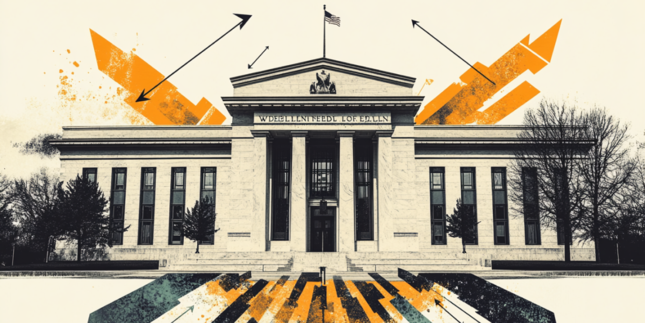One of most important relationships to understand in the forex market is the one between the Swiss franc and euro. There is a very strong correlation between these two, meaning that the Swiss franc tends to rise against the US dollar when the euro does. Because of this, the EUR/ USD and USD/CHF currency pairs are strongly negatively correlated – the correlation can be as strong as -95%. In other words, when one currency pair rises, the other currency pair almost inevitably falls. Keep in mind that the two currency pairs run in opposite directions – if a CHF/ USD currency pair were used instead, both EUR/USD and CHF/USD would move together in the same direction nearly all of the time.
There are two main reasons for this correlation. First of all, the US dollar is the world’s top currency, and the US economy is also the largest. This means that the US dollar is involved in 90% of all currency trades, and the state of the US economy has a major impact on other economies around the world. This means that money tends to flow into and out of the US dollar, impacting all other currencies to some extent. Because of this, there is generally at least 50% or more correlation between currency pairs that involve the US dollar – the strength of the US dollar alone tends to overwhelm any particular strengths and weaknesses in other currencies when setting exchange rates.
However, the relationship between the Swiss franc and euro is even stronger than this. This is because Switzerland is situated directly in the middle of the eurozone, even though it is not part of it. Both the close physical proximity and strong trade ties tend to create a much stronger correlation between the two currencies than is found with other currencies. For example, strong growth in the eurozone translates into strong growth in Switzerland – creating similar upward pressure on both currencies.
Understanding this relationship is very important when managing risk. For instance, if you take a short position in USD/CHF and a long one in the EUR/USD, you are essentially doubling your risk. If the two currency pairs weren’t strongly correlated, then they could rise and fall independently. However, the correlation means that you will gain or lose on both positions at the same time – compounding your losses or profits.
In general, it is not a good idea because of this to trade both pairs. Some inexperienced traders also think that they can use differences in interest rates to carry out arbitrage with these two pairs – for example, going long on both currency pairs so that the risk is zero, and then pocketing the interest differences between the two pairs. However, for various reasons this often doesn’t work, particularly because the correlation is not perfect – the two currencies can decouple at times due to local economic and political factors.
Disclaimer:This written/visual material is comprised of personal opinions and ideas. The content should not be construed as containing any type of investment advice and/or a solicitation for any transactions. It does not imply an obligation to purchase investment services, nor does it guarantee or predict future performance. FXTM, its affiliates, agents, directors, officers or employees do not guarantee the accuracy, validity, timeliness or completeness of any information or data made available and assume no liability for any loss arising from any investment based on the same.
Risk Warning: CFDs are complex instruments and come with a high risk of losing money rapidly due to leverage. 90% of retail investor accounts lose money when trading CFDs with this provider. You should consider whether you understand how CFDs work and whether you can afford to take the high risk of losing your money.
Editors’ Picks

EUR/USD struggles for direction amid USD gains
EUR/USD is trimming part of its earlier gains, coming under some mild downside pressure near 1.1730 as the US Dollar edges higher. Markets are still digesting the Fed’s latest rate decision, while also looking ahead to more commentary from Fed officials in the sessions ahead.

GBP/USD drops to daily lows near 1.3360
Disappointing UK data weighed on the Sterling towards the end of the week, triggering a pullback in GBP/USD to fresh daily lows near 1.3360. Looking ahead, the next key event across the Channel is the BoE meeting on December 18.

Gold losses momentum, challenges $4,300
Gold now gives away some gains and disputes the key $4,300 zone per troy ounce following earlier multi-week highs. The move is being driven by expectations that the Fed will deliver further rate cuts next year, with the yellow metal climbing despite a firmer Greenback and rising US Treasury yields across the board.

Litecoin Price Forecast: LTC struggles to extend gains, bullish bets at risk
Litecoin (LTC) price steadies above $80 at press time on Friday, following a reversal from the $87 resistance level on Wednesday. Derivatives data suggests a bullish positional buildup while the LTC futures Open Interest declines, flashing a long squeeze risk.

Big week ends with big doubts
The S&P 500 continued to push higher yesterday as the US 2-year yield wavered around the 3.50% mark following a Federal Reserve (Fed) rate cut earlier this week that was ultimately perceived as not that hawkish after all. The cut is especially boosting the non-tech pockets of the market.
RECOMMENDED LESSONS
Making money in forex is easy if you know how the bankers trade!
I’m often mystified in my educational forex articles why so many traders struggle to make consistent money out of forex trading. The answer has more to do with what they don’t know than what they do know. After working in investment banks for 20 years many of which were as a Chief trader its second knowledge how to extract cash out of the market.
5 Forex News Events You Need To Know
In the fast moving world of currency markets where huge moves can seemingly come from nowhere, it is extremely important for new traders to learn about the various economic indicators and forex news events and releases that shape the markets. Indeed, quickly getting a handle on which data to look out for, what it means, and how to trade it can see new traders quickly become far more profitable and sets up the road to long term success.
Top 10 Chart Patterns Every Trader Should Know
Chart patterns are one of the most effective trading tools for a trader. They are pure price-action, and form on the basis of underlying buying and selling pressure. Chart patterns have a proven track-record, and traders use them to identify continuation or reversal signals, to open positions and identify price targets.
7 Ways to Avoid Forex Scams
The forex industry is recently seeing more and more scams. Here are 7 ways to avoid losing your money in such scams: Forex scams are becoming frequent. Michael Greenberg reports on luxurious expenses, including a submarine bought from the money taken from forex traders. Here’s another report of a forex fraud. So, how can we avoid falling in such forex scams?
What Are the 10 Fatal Mistakes Traders Make
Trading is exciting. Trading is hard. Trading is extremely hard. Some say that it takes more than 10,000 hours to master. Others believe that trading is the way to quick riches. They might be both wrong. What is important to know that no matter how experienced you are, mistakes will be part of the trading process.
The challenge: Timing the market and trader psychology
Successful trading often comes down to timing – entering and exiting trades at the right moments. Yet timing the market is notoriously difficult, largely because human psychology can derail even the best plans. Two powerful emotions in particular – fear and greed – tend to drive trading decisions off course.
